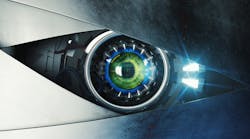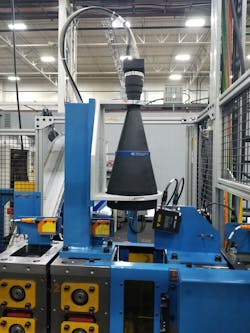Skye Gorter is president of Skye Automation, an automated solutions provider for controls, electromechanical, safety, machine vision and sensor applications, representing a limited number of manufacturers. It is headquartered in Stirling, Ontario, Canada.
Tell us about your company’s state-of-the-art machine-vision technology.
Skye Gorter, president, Skye Automation: Our approach to machine vision is based on using highly developed technologies that allow for the greatest degree of flexibility and overall performance. We feel that it is best to use products that are purpose-built and integrate these together to provide system solutions. In this way, we don’t specifically design or code the fundamentals of the vision system; rather, we are truly an integrator using the most advanced components to provide an efficient customized solution.
At the heart of any vision system is the control system. We choose to use an integrated development environment (IDE) that provides an advanced tool library founded on MVTec algorithms with a simple-to-use interface that allows for fast development of the application. The Q.Vitec software that we develop on provides continuous development of the IDE to meet ever-increasing demands on the vision system.
What have been the biggest improvements to machine-vision technology in the past five years?
Skye Gorter, president, Skye Automation: At the risk of being unpopular, I’m going to say that it is not the advancements of artificial intelligence (AI), although this has a practical application for the right projects. For the typical industrial application that is purpose-built, which is the area of focus for us, there are other more critical developments that simplify and expedite application development and create a more robust solution (Figure 1).
Specifically, precision lighting control integration, flexibility for industrial communications, and the ability to integrate machine-learning (ML) functions easily into the control system have assisted us in developing complex solutions with minimal development time.
What’s the most innovative or efficient machine-vision technology application you’ve ever seen or been involved with?
Skye Gorter, president, Skye Automation: We have had the opportunity to develop some very intriguing applications. One of my favorite projects is where we use multi-spectral lighting with data correlated between multiple images. The purpose is to highlight certain features of the parts being inspected while creating the highest and most reliable contrast.
I like this application because it uses so many elements of the technology, such as:
- image sequencing using different lighting and exposure times
- advanced software tools (FOV perspective correction, virtual cameras, adaptive binarization, and sequenced values, utilizing the best contrast for optimum processing).
How has machine-vision technology benefitted from remote monitoring and connectivity?
Skye Gorter, president, Skye Automation: This has allowed us to expedite developments and provide ongoing service that would be otherwise difficult to accommodate or very costly. For example, we have integrated new parts into vision-guided robotic feeder systems using remote connections. In the past, this would have required a service call and extensive travel time, and the costs to the consumer would be high. Now, this can be achieved in a small amount of time at a reasonable cost.
Can you explain how software development has changed machine-vision technology design and production?
Skye Gorter, president, Skye Automation: We generally integrate our systems on PCs, as we feel this offers a number of advantages particularly suited to machine vision. Using a front end that is designed for fast application development, but that offers backplane communication to the PC-programming environment, as well as fieldbus communications to the industrial networks, allows for a world of possibilities not readily available on traditional vision- or sensor-based products.
We often face resistance to the concept because of preconceived ideas about PC-based solutions. However, the power of using a PC can be quickly recognized, especially when the vision solution is more complex.
The base software is critical to solid vision performance. We use a system that is built on the concept of efficient processing. To this end, the processing tasks are split onto different cores of the CPU. Multiple cameras can intercommunicate, or the images can be easily used in conjunction with each other. The storage capacity becomes highly advantageous for data collection and historical reporting, as well as analytical functions that a PLC would struggle with.
With direct communication from the vision program to Windows, we are able to expand on the functionality of the vision solution to include ML or even AI processing into even routine installations.
How do machine-vision technologies figure into digital-twin platform models being used by manufacturers?
Skye Gorter, president, Skye Automation: We use this model internally for application development, testing and implementing ML solutions. At times, it is necessary to collect images from the installation, but developing the inspections or ML algorithms on the installation platform may be unrealistic. Therefore, we set up a twin platform, typically utilizing a virtual system and provide the data collection and testing off-line.
This provides a lower cost of installation while offering the ability for continuous improvement or off-line testing.
When will machine-vision technology become IT-friendly enough that engineers are no longer required for installation and operation?
Skye Gorter, president, Skye Automation: I’m not an engineer, but I’ve installed hundreds of cameras into all sorts of applications, environments and control systems. I believe that technology such as this is best suited to those who have a passion for it, not necessarily those who have just the qualifications for it.
On the other hand, it seems unlikely that this technology will reach a point in the near future that it is commoditized. In my opinion, the “machine vision in a box” solution has been attempted by at least one or two major companies. Although they may sell many boxes, the lack of technical understanding and specific application development often fail to meet the full intent of the project.
What future innovations will impact the use of machine-vision technology in discrete-manufacturing operations?
Skye Gorter, president, Skye Automation: This is where I do think ML and AI solutions will start to be directed. I believe it’s important for clients to understand why ML or AI systems would be used. Too often I’m asked about doing an AI solution for what amounts to a simple quality-inspection system. In time, I think these technologies will start to be more specific, optimized and simplified for more general industrial applications.
There will continue to be other technological advancements in lighting, control, integration, vision algorithms and tools. All of these advancements mean more capable and robust vision solutions.







